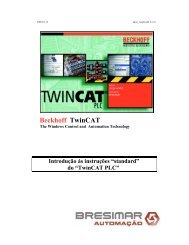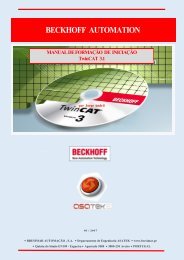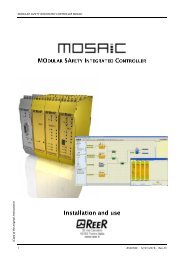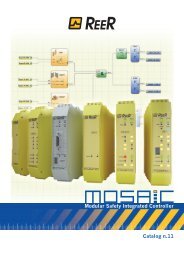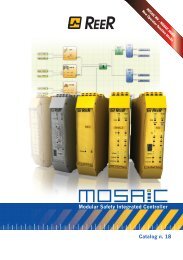BB ELECTRONICS CATALOG (2010)
Catalog from B&B Electronis (2010)
Catalog from B&B Electronis (2010)
You also want an ePaper? Increase the reach of your titles
YUMPU automatically turns print PDFs into web optimized ePapers that Google loves.
CAN Isolator & Fiber Converter<br />
Add Nodes and Protect or Convert CAN<br />
Copper to Fiber<br />
Serial<br />
ISOLATED<br />
CAN in industrial automation<br />
The multi-layer structure of Controller Area Network (CAN)<br />
allows any station on a serial bus to communicate with any<br />
other station. There are also benefits in central control and selfdiagnosis<br />
and correction of transmission errors. A number of<br />
CAN-based higher level protocols have been developed for use<br />
in industrial automation applications. CAN Application Layer<br />
(CAL), CAN Kingdom, CAN-open, DeviceNet and Smart<br />
Distributed System are just a few of these variations.<br />
CAN isolator boosts signal, increases number of nodes.<br />
• Extend the node capacity of your CAN network<br />
• Optical isolation to 2000 VDC. Stops surges and spikes<br />
• DIN rail mount<br />
• Terminal block connections<br />
Optical isolation stops surges Model CANOP extends the node<br />
capacity of your CAN systems and protects your CAN network<br />
from component killing surges and transients. Model CANOP is<br />
an optically isolated CAN repeater that provides 2000 VDC of<br />
optical isolation, allowing you to separate and protect critical<br />
segments of your system from the rest of the CAN network. The<br />
sturdy DIN rail mount case is 4.0 x 3.4 x 1.4 in (9.3 x 8.6 x 3.6<br />
cm). A 10 to 30 VDC power source is required.<br />
CANOP<br />
CANFB<br />
Send CAN signals over fiber for noise resistance and isolation<br />
• Convert CAN signals to fiber and fiber to CAN<br />
• Fiber is naturally resistant to surges, spikes and electrical noise<br />
• DIN rail mount<br />
• Terminal block connections for copper<br />
• ST connectors for fiber<br />
Fiber optic cable offers natural resistance to EMI/RFI noise and<br />
surges that commonly interfere with electrical networks on<br />
factory floors and in industrial environments. Model CANFB<br />
converts CAN signals from copper to fiber and from fiber to<br />
copper. To connect two CAN devices with fiber optic cable, two<br />
Model CANFB converters are required. Copper connections are<br />
terminal block. Fiber connectors are standard ST connectors. The<br />
sturdy DIN rail mount case is 4.0 x 3.4 x 1.4 in (9.3 x 8.6 x 3.6<br />
cm). A power supply of 10 to 30 VDC is required.<br />
Model No. Description Price<br />
CANOP CAN optical isolator, DIN rail mount $149.00<br />
CANFB CAN copper to fiber optic converter, DIN rail mount 199.00<br />
You May Also Need…<br />
MDR-20-12 12VDC, 1.67A DIN Rail Power Supply, Slimline 45.00<br />
Converters<br />
Fiber<br />
Optics<br />
Telephone<br />
Modems<br />
RS-232 Baud Rate Converter & Parallel-to-Serial Port Converter<br />
Convert Data Rates, Formats, Handshaking;<br />
Printer Ports<br />
Different data rates, formats and handshaking?<br />
No problem with this baud rate converter!<br />
Many older devices lack the option to reconfigure baud rate,<br />
data format and handshaking. Model 232BRC acts as a<br />
translator between asynchronous devices, matching each<br />
device’s needs while maintaining the highest possible<br />
throughput. Each side can be individually configured to suit<br />
the device connected to it. The module supports any data rate<br />
up to 115.2 kbps and all standard data formats.<br />
Each side can also supply or accept hardware or software<br />
handshaking, allowing the higher speed device to be located<br />
on either port. A PC is used to configure the Model 232BRC,<br />
but once configured, the module may be installed on any<br />
system. Non-volatile memory maintains all parameters when<br />
power is removed. Each port buffers 16K bytes of data. LED<br />
indicators on each port signals when data is present in the<br />
buffer. The connectors are DB9 female on port A, DB9 male on<br />
port B. Model 232BRC requires 12 VDC @ 100 mA. Module<br />
dimensions are 5.8 x 3.6 x 1.2 in (14.6 x 9.1 x 3.0 cm). A power<br />
supply is available.<br />
Change a Serial Port to a Parallel Port or Vice Versa<br />
Parallel to Serial Converters<br />
(232SPS2)<br />
232BRC<br />
• Port-powered<br />
• Easy installation<br />
• Works with existing software<br />
• Operates as parallel-to-serial or serial-to-parallel converter<br />
• Baud rates up to 115.2 kbps<br />
• 96-byte buffer prevents data loss<br />
• Dimensions: 4.3 x 1.7 x 0.8 in (10.9 x 4.3 x 2.0 cm)<br />
The Model 232SPS2 converts data from a parallel port to a<br />
serial communication format, or from a serial port to a parallel<br />
communication format. Connects directly between computer<br />
and printer without making any software modifications. The<br />
serial port has a female DB25 connector and supports X-On/X-<br />
Off control as well as hardware handshaking. It supports<br />
standard baud rates from 1200 to 115.2 kbps, and Acknowledge,<br />
Busy, and Strobe on the parallel port. 8-position dipswitch<br />
configures the 232SPS2 to match system. The unit can be portpowered<br />
using DTR and RTS on the serial port or powered<br />
externally using 7 to 18 VDC. A power supply is available.<br />
Model No. Description Price<br />
232BRC RS-232 baud rate converter $219.00<br />
232SPS2 Parallel-to-serial converter 109.00<br />
You May Also Need…<br />
232PS 120 VAC to 12 VDC @ 100 mA power supply 15.00<br />
Specialty<br />
Converters<br />
Splitters,<br />
Combiners,<br />
Data Taps SEL<br />
Data<br />
Switches Cards<br />
Fiber Optic Cables<br />
pages 140-141<br />
www.bb-elec.com<br />
815.433.5100<br />
29


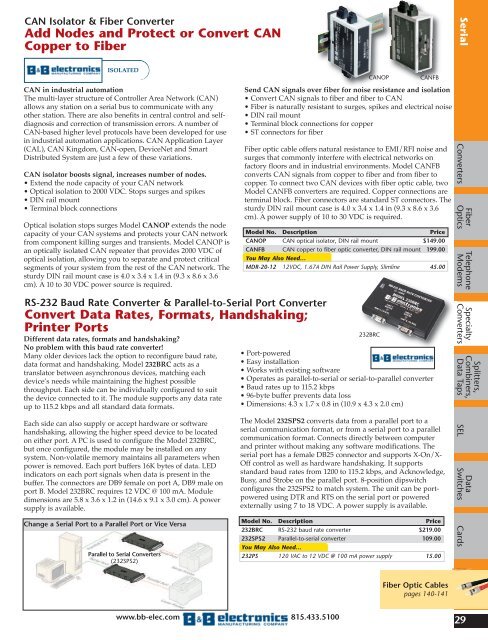


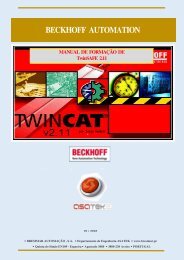
![BRESIMAR(asaTek)-Beckhoff-Livro Formação Técnica TwinCAT 2-v1.2_2009 [pt]](https://img.yumpu.com/62853104/1/190x245/bresimarasatek-beckhoff-livro-formacao-tecnica-twincat-2-v12-2009-pt.jpg?quality=85)
